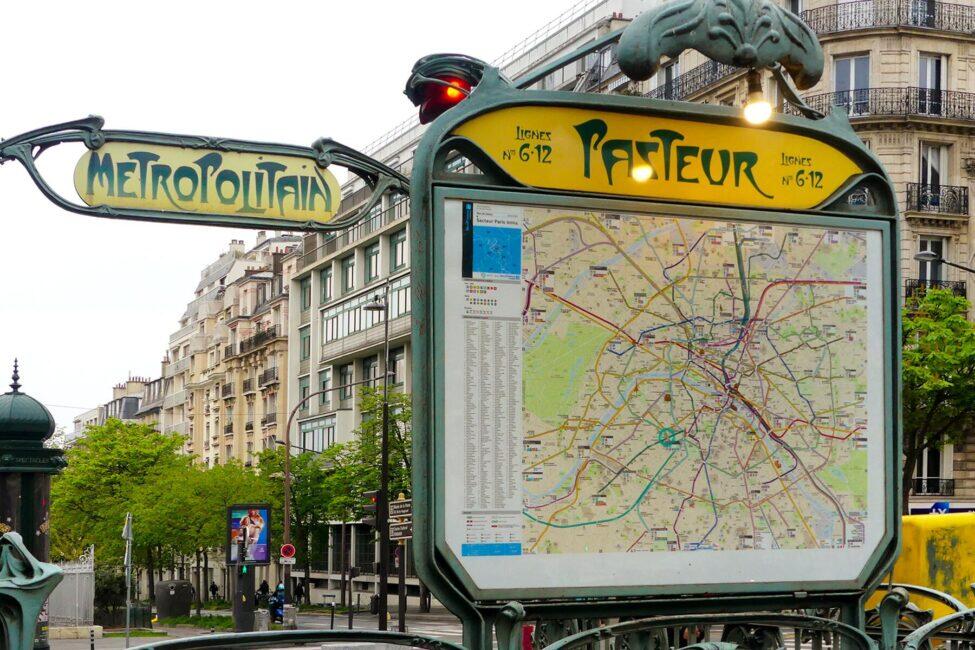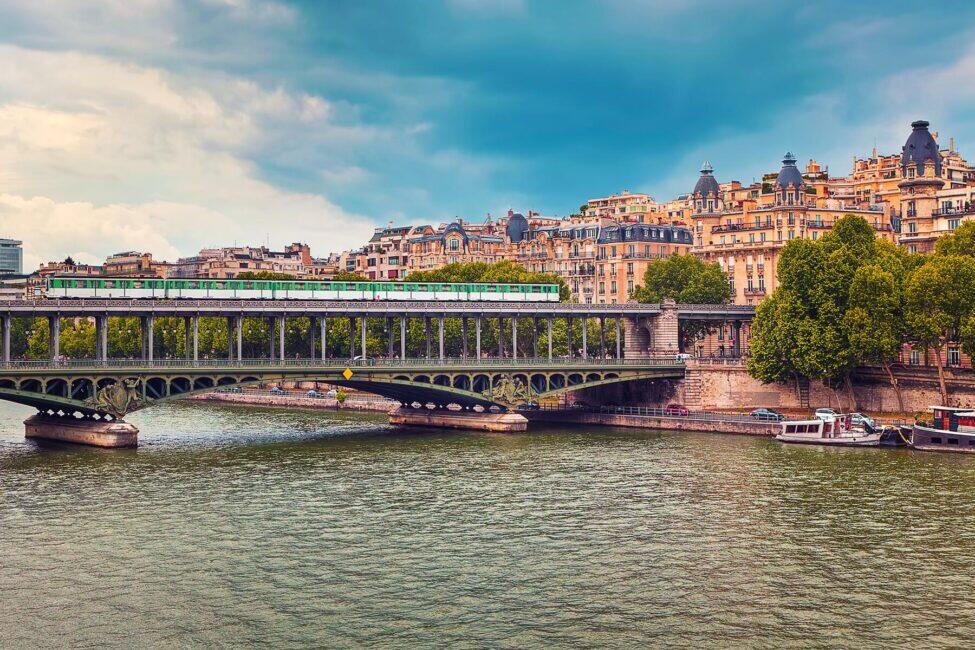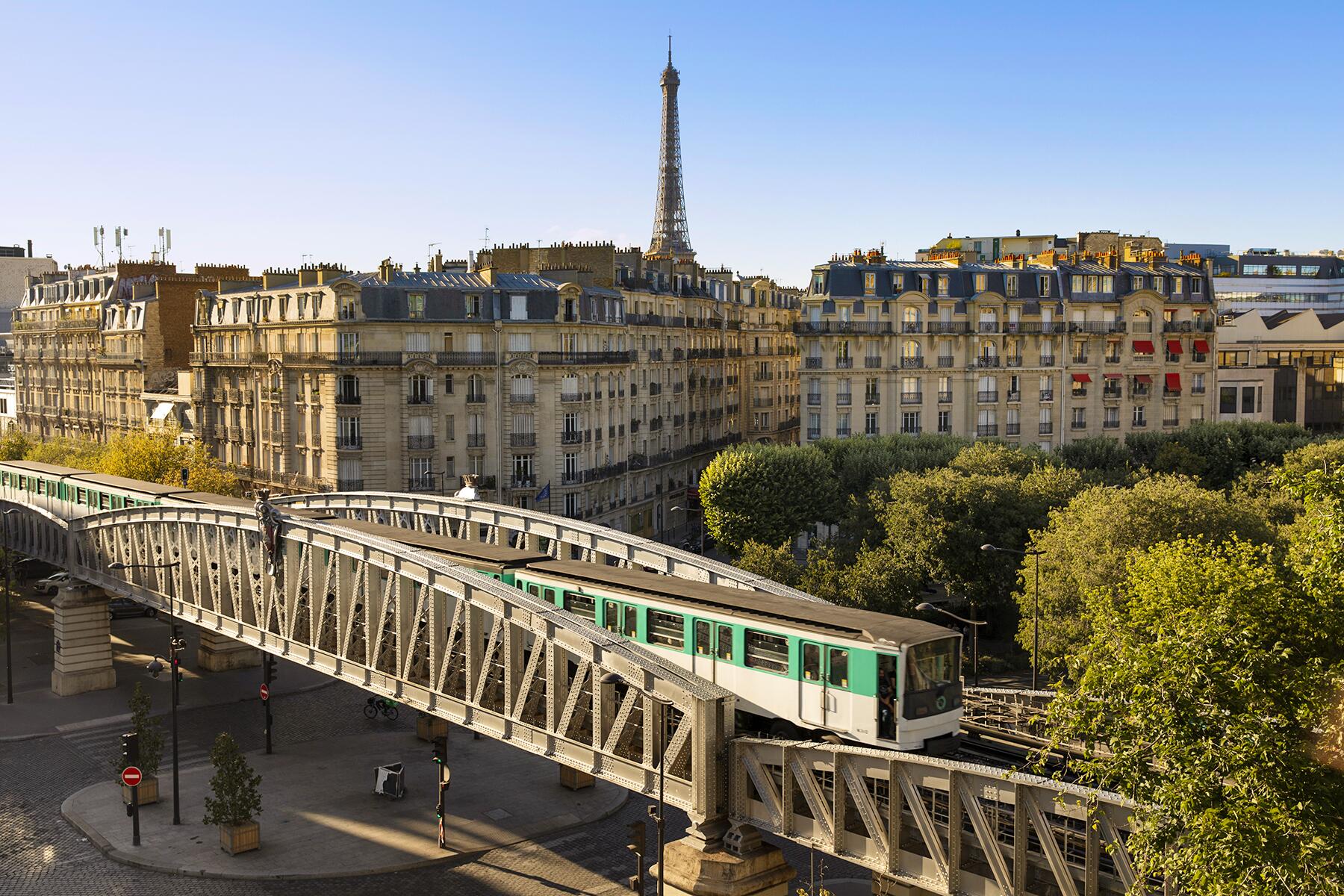Pro tip: A simple “excusez-moi” goes a long way.
“Metro, boulot, dodo…metro, work, sleep”—that’s Parisian shorthand for the daily routine of Parisian life. The metro is a fundamental facet of life in the capital and a convenience every visitor should consider.
Not only is the metro fast, clean, easy to navigate, economical, safe, and on time, it’ll put you within five minutes—10 at the most—of any destination in Paris and scores of must-see places outside the city limits.
Operated by the RATP (Régie Autonomie des Transport Parisiens), the Paris metro is one of the world’s oldest and most comprehensive systems, debuting on July 19, 1900, to mark the Paris World Exposition. Today, the network comprises 16 lines—all identified by a color and a number—serving 309 stations, each spaced about a third of a mile apart. The metro system runs more than 600,000 miles daily (about 24 times around the world).
Related: The Best Things to Do in Paris
Navigating the Metro
Metro trains always arrive from the left as you face the platform and come anywhere from two to 12 minutes apart (the average wait is two to four minutes on weekdays and eight to 10 minutes late evenings), depending on the line and the time of day. Every line is equipped with electronic signage that tells you when to expect the next two trains.
Recommended Fodor’s Video
Lines are easy to navigate once you get a feel for how the signage is organized. In every metro station, you’ll find a map of the entire network, which orients you to where you are in the city and directs you toward where you want to go. Once you identify the line you need to take, you’ll need to determine if you’re headed north or south, east or west, as each line goes in both directions.
If you know the stop you want but not the direction, no worries—on the descent to each train tunnel, you’ll find a listing of the line’s two destination points and every stop in between—just locate your stop on the list and head in that direction. Once on the platform, an overhead sign will confirm which direction you’re going, and signs in the metro car indicate all the stops and where you can transfer to another line.
If you’re unsure and need some help, especially with transfers (which are well marked at each station), ask the attendant at an information booth, although these are quickly disappearing. Better yet, the Paris metro app, accessible in English, is hands down your best resource. Just open to the home page, punch in where you’re headed (it knows where you are), and receive a detailed itinerary.
When exiting the station, look for the handy neighborhood map that shows you precisely where you are and orients you to the neighborhood. This can be essential in larger metro stations with multiple exits.

Buying Tickets and Navigo Passes
Though the RATP has been trying to retire paper tickets for years, you can still buy them in singles or a carnet of 10 tickets. However, many prefer the Navigo Easy Pass, a plastic card you can purchase and recharge from machines at every metro station, choosing the number of rides you need.
All of the machines have an English option and take American credit cards (some still take cash in euros). As of summer 2023, a single ride costs €2.10. For a discount, the Navigo daily or weekly pass (€8.45; €26.10) gives you unlimited rides—a fantastic deal if you plan to be on the go. Be aware that lines get controlled occasionally, and you may be asked to show your ticket or pass, so don’t throw your ticket away until you’ve exited the metro.
The Paris metro starts up at 5:30 am, and the last metro leaves its terminus station at 12:40 am, 1:40 am on weekends (meaning you’ve got some extra time as the train progresses down the line).

Metro Safety
Pickpockets are a problem on the metro trains. However, if you take precautions, you and your valuables will be perfectly safe. Keep purses zipped and wallets safely stowed in a travel pouch or other well-protected bag. Be aware of who’s around you, particularly groups of adolescents that sometimes work together to distract and skillfully relieve you of your wallet.
Parisians are hip to the scam and will often alert unsuspecting riders. Although phone theft is not as prevalent as it was, be very aware of your phone as doors open and close, and if you’re seated near an exit, make sure your phone is not easily grabbable. This is how thieves make their getaway.
Reduced-Mobility Access
Infamous for its many staircases both up and down, the Paris metro is woefully behind the times in creating access for people with reduced mobility, and this is an ongoing headache for the City of Paris. Measures are now limited to a vocal recording announcing every station in five languages (lines 1, 9), but only metro line 14 is entirely wheelchair accessible. In April 2023, President Macron earmarked an additional 1.5 billion to enhance accessibility in the city.
As host of the 2024 Olympic and Para Olympic Games, Paris is scrambling to find ways to accommodate visitors with reduced mobility. In lieu of metro access, the city is planning shuttles to and from Olympic venues that spectators can book in advance. On the other hand, all of Paris’s tram lines are fully wheelchair accessible.
Tram and RER
The Paris tramway consists of 12 fully automated above-ground lines that run along the periphery of Paris. The trams are convenient to all the Paris portes (doorways at the city’s edge), Paris’s three flea markets—St. Ouen-Clignancourt, Vanves, and Montreuil—as well as the Bois de Vincennes (at Porte Dorée) and the Bois de Boulogne (at Porte D’Auteuil, Porte Maillot, and Porte Dauphine). The trams offer views and can be a relaxing way to sit back and take in the city.
It’s also wise to consider the RER. This faster express train travels between all the principal hub stations, including all of Paris’s six SNCF train stations (Gare du Nord, Gare de l’Est, Gare de Lyon, Gare d’Austerlitz, Gare Montparnasse, Gare Saint-Lazare) if you’re heading to points farther afield in France. There are five RER lines, which can make your trip across town faster and will also take you to the Paris airports (RER B), Versailles (RER C), and Disneyland Paris (RER A).

Metro Etiquette
Once onboard, there are just a few rules to follow to go with the Parisian flow. First, don’t push your way on or through a crowded metro car shouting, “excuse me!” It’s simple enough to learn “excusez-moi” or “pardon.” Also, do relinquish your seat to an elderly, pregnant, or disabled person, as you would on any public transport, and be mindful of remaining seated in a folding chair on a crowded train when standing would give everyone aboard more room. If you’re in a group, modulate your voice since Parisians are sensitive to raucous tourists.
Metro App
If you’re headed to Paris and plan to use the metro, be sure to download the RATP’s essential metro app. This will allow you to type in your itinerary and get detailed directions on all your metro options on how to get there and precise timing, including by metro, tram, bus, bike, and on foot.
Metro Rides With a View
Metro lines 2 and 6 are partly above ground, and line 6 offers great views of the Eiffel Tower and the Seine River. The best views are from the right side of the train if heading toward Charles de Gaulle-Étoile and on the right if going toward Nation. The best views are from Passy to Bir Hakeim—a historic metro station that spans the city’s only pedestrian, metro, bicycle, and automobile bridge. This is a great place to hop off for picture-perfect views of the tower and river.

Metro Tourism
Art Nouveau was all the rage at the dawn of the Paris metro, and visitors can still see the iconic cast-iron entrances with their sinuous pillars and glass overhangs around the city. Designed by architect Hector Guimard, the best-preserved of these graceful edifices can be found at Saint-Michel, Cité, Palais Royal-Musée du Louvre, Abesses, Ternes, Monceau, Porte Dauphine, Réamur-Sébastopol, and Pigalle.
Certain landmark interiors are lovely to see, too, like the beautiful mosaics at Liège, all in Delft blue-and-white mosaic tiles; Varenne with two of Rodin’s most iconic sculptures (it’s a two-minute walk from the Musée Rodin); Louvre-Rivoli, a darkened station that features treasures from the Louvre—all casts made at the famous RMN (Réunion des Musées Nationaux) “moulages” workshop, that can be purchased in any size from their store—and Cluny-La Sorbonne’s ceiling mosaics that name the French luminaries who lived in the Latin Quarter.
Why Take the Metro?
If you’re not convinced, consider Paris’s dense automobile and now bicycle traffic that can make navigating the city by taxi or Uber very time-consuming and treacherous. For example, crossing from the Arc de Triomphe (Étoile station) to Saint-Germain-des-Près by Uber during peak hours can take upwards of 40 minutes, by metro, it will take 10-15. A great reason to consider the metro as a quick and easy way to navigate Paris.



